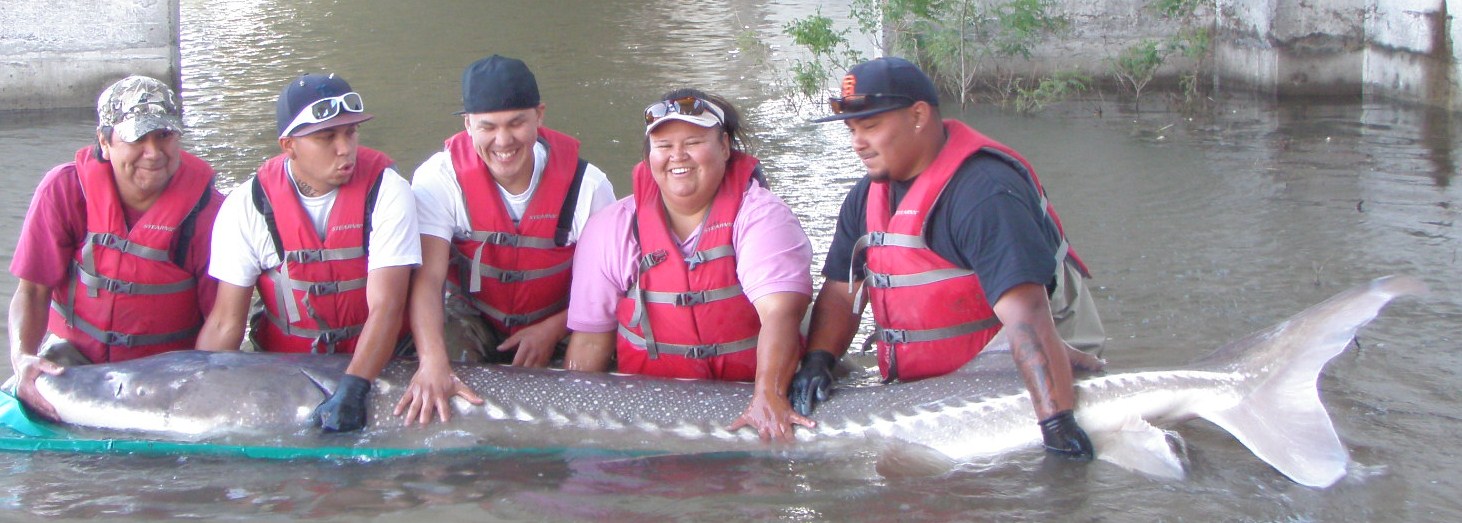Technical Recommendation 13
Sturgeon
Develop artificial propagation and management strategies for white sturgeon populations above Bonneville Dam.
Current Status
White sturgeon populations upstream of Bonneville Dam are reservoir-based populations, with the exception of sturgeon that occupy the Hanford Reach. Sturgeon in Hanford Reach are bounded by Priest Rapids, McNary, and Ice Harbor dams. Tribal subsistence and commercial fisheries currently occur in Bonneville, The Dalles and John Day reservoirs, with harvest guidelines for each reservoir of 1,100, 1,000, and 1,000 sturgeon, respectively. Population abundances (i.e., estimates of all sturgeon greater than two feet in length) are highest in Bonneville reservoir, which has approximately 300,000 sturgeon. The Dalles reservoir population is estimated at 85,000, while the John Day reservoir population is estimated at 42,000. Harvests are currently stable, although fishers will experience some downturns in harvestable numbers over the next decade, particularly in the John Day reservoir. In the longer term, fishers’ catches will vary with river flows as recruitment is positively related to spring flows. Such variation will continue until spring flows are adjusted for sturgeon spawning or more likely until a hatchery program begins releasing sturgeon into reservoirs with poor recruitment.
Assessment
Most of the study recommendations in the 1995 Spirit of the Salmon Plan have been conducted. The findings were incorporated into a Sturgeon Master Plan, developed under the Columbia Basin Fish Accords process. The white sturgeon decline that was apparent in 1995 has generally reversed, but Columbia River sturgeon above Bonneville Dam are still at risk. The survival of young sturgeon (i.e., recruitment) varies depending on annual flows. Studies have verified that spring flows with greater than average discharge and longer than average duration are beneficial for sturgeon. Flow requirements for listed salmon juvenile outmigrants overlap with sturgeon spawning periods and may benefit sturgeon, but modifying flows to specifically benefit sturgeon spawning is unlikely in the near future.
Periodic or regular releases of juvenile hatchery sturgeon could be used to offset similar periods of poor or marginal natural recruitment. Such a hatchery has the potential to stabilize sturgeon populations, which in turn could increase and stabilize tribal harvests over the long term.
Beginning in the late 1990s, CRITFC staff began a multi-year project, funded by the Bonneville Power Administration, to determine the feasibility of collecting, holding and spawning white sturgeon upstream of Bonneville Dam. The efforts included detailed release strategies for juvenile sturgeon of various ages to determine growth, entrainment and survival over time. These investigations were to provide information for hatchery release strategies.
Funding cuts precluded completion of these efforts, although an estimated 20,000 yearling white sturgeon were released in Rock Island reservoir in 2003. Since 2003, researchers have caught hundreds of hatchery sturgeon downstream of Rock Island reservoir. Nearly 50% of the released hatchery yearlings have survived and are growing an average of 10 cm per year; many of these fish are now 4 feet in length.
In 2008, under the U.S. v. Oregon Fish Management Agreement and the Columbia Basin Fish Accords, federal and state agencies committed to resuming studies to estimate present and optimum population levels, life history characteristics, recruitment, spawning potential and appropriate sturgeon fishing sanctuaries. The U.S. v. Oregon entities also agreed to consider artificial propagation, transplantation and flow augmentation, which were key recommended actions in the 1995 Spirit of the Salmon plan.
As part of the Sturgeon Master Plan, the Accords have funded a project to determine if a sturgeon hatchery can be used to prevent declines in sturgeon populations upstream of McNary Dam and in Zone 6, particularly in the John Day reservoir. Although the largest by area, John Day reservoir has the smallest sturgeon population of the three Zone 6 reservoirs. (Zone 6 is the stretch of Columbia River encompassing Bonneville, The Dalles, John Day and McNary dams. The three reservoirs, or pools, are Bonneville, The Dalles and John Day.)
As the Accords’ Sturgeon Master Plan progresses, regional co-managers (i.e., states and tribes) will employ data from the 2003 release to complete plans for hatchery sturgeon releases in Zone 6 reservoirs and impoundments upstream of McNary Dam.
New and Modified Actions
- Complete and submit a plan for a sturgeon hatchery, including draft construction designs and identification of potential locations, as well as the justification and rationale for construction of a facility. (Step 1 of the 3-step Sturgeon Master Plan)
- Complete an evaluation of the hatchery design and production goals before construction begins. (Steps 2 and 3 of the Sturgeon Master Plan.)
- Work to decrease toxic contamination in the mainstem so the fish health advisory can be lifted. (Also see the technical recommendation Water Quality.)







